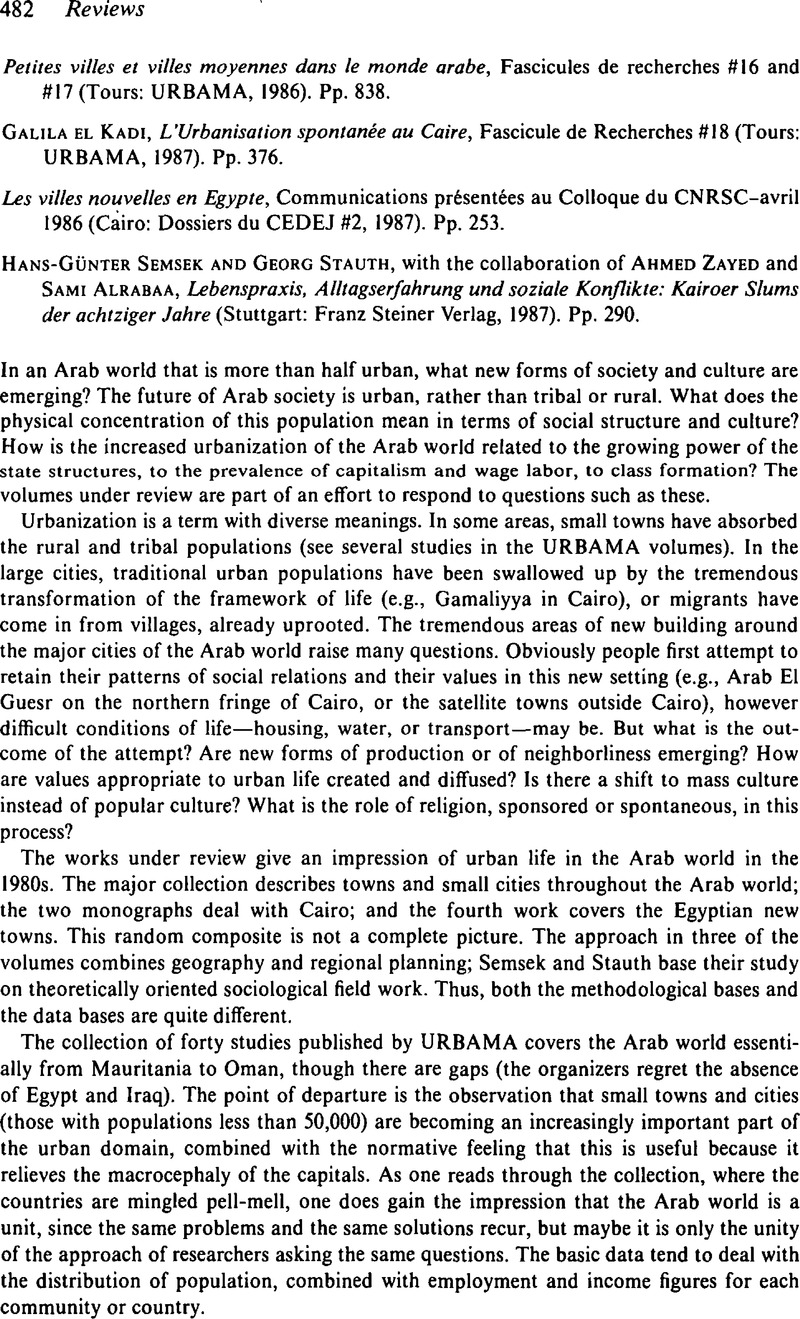No CrossRef data available.
Article contents
Petites villes et villes moyennes dans le monde arabe, Fascicules de recherches #16 and #17 (Tours: URBAMA, 1986). Pp. 838. - Galila el Kadi, L'Urbanisation spontanée au Caire, Fascicule de Recherches #18 (Tours: URBAMA, 1987). Pp. 376. - Les villes nouvelles en Egypte, Communications présentées au Colloque du CNRSC-avril 1986 (Cairo: Dossiers du CEDEJ #2, 1987). Pp. 253. - Hans-Günter Semsek and Georg Stauth, with the collaboration of Ahmed Zayed and Sami Alrabaa, Lebenspraxis, Alltagserfahrung und soziale Konflikte: Kairoer Slums der achtziger Jahre (Stuttgart: Franz Steiner Verlag, 1987). Pp. 290.
Published online by Cambridge University Press: 29 January 2009
Abstract

- Type
- Reviews
- Information
- Copyright
- Copyright © Cambridge University Press 1990
References
1 This process is also described for Hayy al-Salam in Ismailiyya, see Villes nouvelles, pp. 187–217. For another view of the process of subdivision and encroachment on farmland, see Ireton, François, “Du limon au beton: l'urbanisation spontanée à Bulaq el-Dakrur,” in Bulletin du CEDEJ 24 (1988): 121–50.Google Scholar
2 Some idea of the processes involved can be gained from a series of studies including Nadim, Asaad et al. , “Living without Water,” Cairo Papers in Social Science 3, 3 (1980)Google Scholar; Taher, Nadia Adel, “Social Identity and Class in a Cairo Neighborhood,” Cairo Papers in Social Science 9, 4 (1986)Google Scholar; Oldham, Linda, Hadidi, Haguer el, and Tamaa, Hussein, “Informal Communities in Cairo,” Cairo Papers in Social Science 10, 4 (1987).Google Scholar The Nadim study in particular, originally done for E. S. Parsons Co., provides a large part of the foundation for the El Kadi and Semsek and Stauth volumes.
3 Some of the material from this study has appeared in English. See Alrabaa, Sami, “Arbitration Discourse in Folk-Urban Egypt,” in Peuples Mediterraneens 34 (1986): 65–87Google Scholar; Semsek, Hans-Gu'nter, “Popular Culture Versus Mass Culture: The Social Dynamics of a Popular Cairene Quarter, A Case Study,” in Stauth, Georg and Zubaida, Sami, eds., Mass Culture, Popular Culture, and Social Life in the Middle East (Frankfurt and Boulder, Colo., 1987), pp. 261–85Google Scholar; Ahmad Zayed, “Popular Culture and Consumerism in Underdeveloped Urban Areas: A Study of the Cairene Quarter of al-Sharrabiyya,” in ibid., pp. 287–312.
4 Much more vibrant are new communities in some of the new agricultural zones, such as Badr in South Tahrir, where individual choices to move amplify and modify a planned base. On planned communities in Aswan and Mersa Matrouh, see also Zeid, Ahmed Abou, “New Towns and Rural Development in Egypt,” Africa 49, 3 (1979): 283–90.CrossRefGoogle Scholar
5 Southall, Aidan, “Small Urban Centers in Rural Development: What Else Is Development Other Than Helping Your Own Home Town?,” African Studies Review 31, 3 (1988): 1–15, esp. p. 3.Google Scholar
6 See Mead, Donald C., “Small Industries in Egypt: An Exploration of the Economics of Small Furniture Producers,” in IJMES 14 (1982): 159–71Google Scholar; Meyer, Gu'nter, “Employment in Small-Scale Manufacturing in Cairo: A Socio-Economic Survey,” British Society for Middle Eastern Studies Bulletin 14, 2 (1988): 136–46.CrossRefGoogle Scholar




